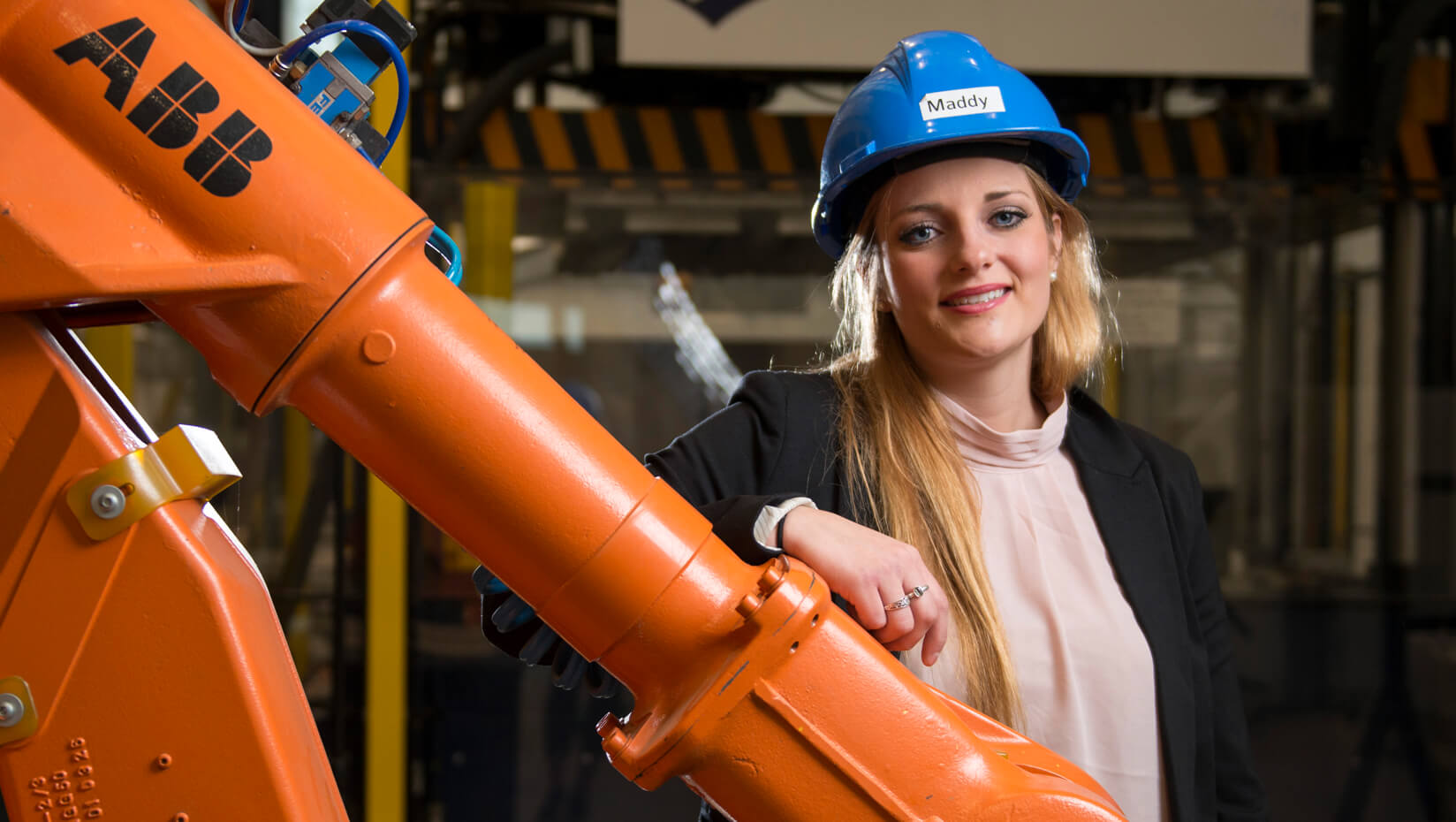
Madeline Wehrle: Researching structural thermoplastics for use in medical field
Madeline Wehrle was interested in medicine from an early age. After being introduced to isometric drawing and computer-aided design, or CAD, modeling in high school, she also became interested in bioengineering.
“It was more of a realization that innovation or engineering is applicable to whatever field you are most passionate about — which for me was medicine,” says Wehrle of Wiscasset.
Wehrle is now a senior bioengineering major with a minor in nanotechnology at the University of Maine.
Since 2013, she has been working in the Advanced Structures and Composites Center. Initially hired as lab cleaner, Wehrle quickly shifted to other positions with more responsibilities.
After one day as a cleaner, she moved to the laboratory operations office where she spent about a year and a half assisting with the training program, giving tours, and maintaining calibration records.
“I found myself looking for excuses to get closer to the many research projects in the lab,” Wehrle recalls.
Now Wehrle is one of about a dozen students researching in the center’s new Alfond Advanced Manufacturing Laboratory for Structural Thermoplastics under the direction of David Erb, a senior R&D program manager. Researchers in the lab are using digital, additive and robotics manufacturing to reduce cycle time and cost of traditional manufacturing.
Wehrle and Erb work as part of the Consortium for Manufacturing Innovation in Structural Thermoplastics (CMIST).
In May 2015, the National Institute of Standards and Technology (NIST) awarded the UMaine Advanced Structures and Composites Center $497,965 for mapping technical manufacturing challenges in structural thermoplastic materials. Through the award, UMaine Composites Center formed CMIST with the U.S. Army Corps of Engineers’ Engineer Research and Development Center (ERDC), Celanese Corp., Eastman Chemical Co., PolyOne and Royal TenCate. CMIST has more than 70 members and is led at UMaine by Erb and Roberto Lopez-Anido, a professor of civil engineering.
“We have been working to create a road map to detail the complex process structural thermoplastic materials must undergo to be adopted as an accepted industry standard,” Wehrle says.
The use of thermoplastic composite materials for structural applications is a segment of the manufacturing industry that has potential for growth because of the material’s desirable qualities, according to CMIST. Thermoplastic composites are low cost, low weight, recyclable, corrosion resistant and are strong enough to be used as a substitute in many primary structural applications. The group aims to solve technical issues that exist while also disseminating the knowledge it has cultivated so U.S. manufacturers can advance their solutions to market.
Wehrle’s responsibilities for CMIST include assisting with writing annual reports to NIST.
Wehrle also has been conducting a feasibility study on additive manufacturing in surgical tooling with the help of an orthopedic surgeon from New Hampshire.
She says the study integrates her degree program with her work at the center.
“CMIST is focused on structural thermoplastics and realizing the struggles industry must overcome in order for them to be adopted into accepted manufacturing process,” she says. “In hopes of benefiting the medical industry, I have been designing, analyzing and processing, and manufacturing potential 3-D printed tools.”
The tools Wehrle are researching could potentially be created on-site in hard-to-access areas including military sites and developing nations, where equipment and materials are not readily available.
“Knowing that my research has the potential to impact not just one life, but potentially many, many more, is the motivation I need to put into my studies and work,” she says. “Also, the medical field is constantly updating and expanding its knowledge base. Bottom line: It is impossible to get bored.”
This February, Wehrle traveled to California for a workshop held by a parallel consortium, Biomedical Devices and Equipment Consortium Organization to Roadmap Industry (BIOCOR), which is run by the University of Southern California. The aim of the event was to identify technical challenges in the field of biomedical devices, according to Wehrle.
“UMaine has provided me with more than I could have ever envisioned when I originally applied,” she says. “My job at the Advanced Structures and Composites Center has really connected me with industry. I have met many people during my time at the center — all who have provided me a huge amount of personal and professional advice and knowledge.”
Wehrle says she considers Erb to be her most influential mentor during her time at UMaine.
“He has consistently given me an opportunity to explore a field that I love — biomedical engineering — although traditionally our work lies more in mechanical and civil engineering,” she says, adding that he has provided her with the groundwork for a successful career through multiple introductions to academic and industry professionals.
“His positivity and passion for exploring new R&D projects with an open mind is something that I hope to utilize throughout the rest of my life,” she adds.
Wehrle’s advice for incoming college students is to work hard and continuously put yourself in a position to open doors.
“Find yourself a facility that you find interesting, even if the first job offering is low in the grand scheme of operation,” she says. “You have to first put yourself in the ideal setting to pave a career path for yourself, the rest will fall into place.”
After graduation in December, Wehrle says she hopes to continue exploring structural thermoplastics and everything they have to offer the medical field.
Contact: Elyse Catalina, 207.581.3747
Madeline Wehrle: Researching structural thermoplastics for use in medical field
